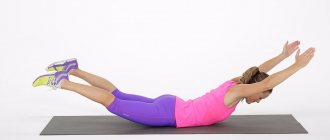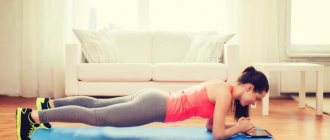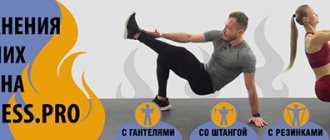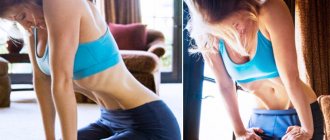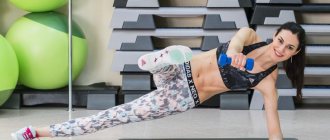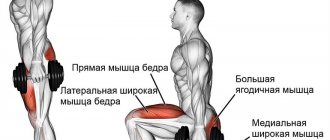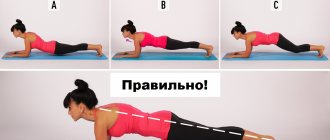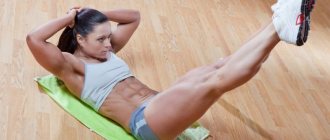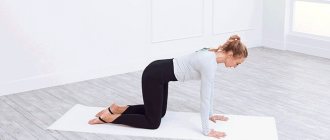Lifting the pelvis while lying down will eliminate back pain
Weakened gluteal muscles from lack of activity are a sure way to back pain. When the erector spinae and hamstring muscles take over the work that the gluteal muscles should do, what is called gluteal amnesia occurs. This leads to the fact that the load that should be taken by the hips is transferred to the lower back, which is not designed for this purpose. As a result of this, back pain appears.
Do a glute bridge every day to awaken your gluteal muscles and pelvic area. This will ensure your body remembers to use your glutes for movement rather than your lower back.
Bridge complication
Having thoroughly practiced the classic version of the bridge, you can try to perform the exercise from a standing position.
Descent and ascent along the wall
Stand with your back to the wall at a distance of 2 steps from it. Bend back and press your palms against the wall. Point your fingers down.
Take small steps with your hands along the wall and thus lower yourself to the floor. You can step back a little with your feet so that the distance to the wall is comfortable. Stand on the bridge for a few seconds.
Now you need to climb back onto the wall with your hands. This is more difficult than descending and requires more effort. All movements are performed in reverse order. At the end point, you must return to the starting position - standing with your back to the wall.
Step back and forth 8 times, do 2 sets.
Bridge from a standing position
Stand straight, feet shoulder-width apart, hands on your waist. Further:
- Bend your knees and bend your pelvis forward, tilt your head back. You must see the space behind you.
- When you feel that further deflection will lead to loss of balance, raise your arms and bend your hands so that your fingers are pointing back.
- Move your arms back as far as possible, bend your back, move your pelvis forward and spring your legs. Your task is to overcome the fear of falling and land softly with your palms on the floor behind your back.
- When your hands touch the floor, hold the bridge for a few seconds and lower yourself to the floor.
You can ask your partner to secure you by holding his hand under your back. This exercise requires well-developed flexibility and coordination.
When you manage to complete it in 2 sets of 5 times in a row, you can proceed to the last step.
Relieves knee pain
One of the main causes of knee pain is poor femoral control, i.e. it may slide forward slightly, evert out, or move closer to the center of the body. Such frequent movements lead to knee pain. The gluteal muscles play an important role in controlling the femur at the hip joint, which affects the movement of other bones connected by the knee joint.
A butt bridge (especially the one-leg version) will “teach” the femur to be in the correct position and relieve knee pain.
Additional equipment for the back
To gently stretch the spine, there is a special simulator - a back bridge. The device not only stretches, but also massages the back muscles. It works in several levels, allowing you to gradually increase the stretch. The good thing about a back bridge massager is that you don’t need to do any exercises, you just need to lie down on it, and the exercise machine will do all the work itself.
Performing a bridge will help strengthen the main central muscles and, as a result, improve the overall condition of the body. After strengthening these groups, it is much easier to do other exercises, since the core supports the whole body. It is quite possible to be healthy and fit, without gyms and personal trainers!
Many instructors working in gyms and fitness clubs claim that the gymnastic exercise “bridge” is the most useful and allows you to achieve the highest level of training of the muscular corset in the spine. What is this opinion based on?
Progressive exercise options
If the basic exercise has become too simple and does not provide the required load, you can move on to more advanced options:
- Back bridge on one leg.
- A weighted bridge, with dumbbells or other available weight held on the hips.
- Bridge with ribbon. The exercise band is placed across the thighs and held in both hands to provide resistance.
- High bridge. For this type of exercise you will need a training ball or other platform. The feet are raised onto the fitball, the rest of the exercise is performed as in the basic one.
Peculiarities
The sports device in question is also called “Bridge”.
With its help you can get rid of back pain, correct posture, strengthen and stretch muscle groups. The compact “Healthy Back” exercise machine is perfect for home use and is recommended for people of all age groups, regardless of weight and height. Experienced athletes and beginners can exercise with this device. The simplicity of the design makes it possible to operate the unit without special skills and additional assistance. It is intended both to get rid of spinal diseases and to prevent them. Using this device, morning exercises are performed and muscle tension is relieved at the end of the working day. A set of classes lasts 5-15 minutes, if necessary, the load is increased.
https://youtu.be/XKHe2xQ1x4I
Carrying out intensive training on the effective “Healthy Back” simulator contributes to:
- improved stretching of the spinal column;
- improving flexibility;
- relief from muscle spasms;
- preventing the development of pathologies;
- relieving pain symptoms.
The device is focused on the thoracic and lumbar spine.
Description
Modern workloads are gradually making us sick people. We are not designed to sit at a desk all day long! The spine is the first to suffer. A forced sitting position provokes its incorrect bending. There should be an inward deflection in the lumbar region, but it smoothes out and gradually disappears. The connections between the discs of the spine are disrupted, and the functioning of internal organs changes. It is possible to stop the process! The only way is to strengthen the back muscles; gymnastics is needed to strengthen the back muscles and spine. But where can you find time to go to the gym? Most of us won't have it in our schedules. It’s hard to force yourself to even do spinal gymnastics at home!
An excellent solution would be a simple-looking device for relieving stress from the spine, the Bridge (Back Magic). Two plates fold into an arch that simulates an ideal lumbar deflection. 5 minutes of relaxation on it will give you the strength to get through a hard day without clutching your lower back every minute. Here it is, a wonderful relief from spinal pain!
Back without problems in 10 minutes a day - a simulator for relieving stress from the spine with White Back Magic magnets.
- Twice 5 minutes a day and you will immediately feel the results
- no special training required - suitable for everyone
- compact, does not take up much space
- three difficulty levels, you can gradually increase the load
- Built-in magnets increase efficiency
The Back Magic back trainer effectively relaxes the muscles by relieving the compression load.
- The exercise machine is very easy to use; it consists of only two parts: a base and a back support with magnets.
- At your request, you can install the support with the magnets up or down.
- Magnetic protrusions perform an additional acupuncture function.
If you are just starting to use a device for relieving stress on your back, then start with the first level of bending, 2-3 minutes per session, gradually increasing the time.
- Model of the simulator “Back without problems in 10 minutes a day”
- Color: white, black
- Material: nylon, plastic
- Style: for men and women
- Massager type: back
- Weight: 590 g
- Dimensions: 380x60x250 mm
Watch the video instructions for Magic Back Support
“Bridge”: the benefits and harms of exercise for human health
The brain, including the spinal cord, is the most important part of the human body.
Therefore, supporting the muscular corset of the back and the flexibility of the spine provides significant benefits. Spinal injuries can leave a person confined to a wheelchair for life. The spinal column is securely fixed by ligaments and muscle tissue. They serve as protection that protects bone elements, and, consequently, the spinal cord from injury.
In addition, thanks to the elasticity of the muscles, the mobility of the spine is ensured, and its deflections and straightening can be easily performed.
By providing the “bridge” exercise with flexibility of the spinal column and training the muscles by stretching the back, a person fully controls his movements, develops excellent coordination, preventing the development of diseases such as muscle atrophy, neuropathic pathologies, and osteoporosis.
By the way, a person’s breathing largely depends on the elasticity of the spinal muscles and the flexibility of the spine, since the mobility of the diaphragm is partially ensured by the work of the musculoskeletal skeleton. Therefore, the bridge exercise is useful for many diseases of the respiratory system. And supporting the proper functionality of the spine and spinal cord guarantees deep sleep and a reduction in nervous disorders.
By performing a gymnastic element 2-3 times a week, you can achieve the following results:
- strengthen the deep back muscles and increase the flexibility of the spinal column, improving posture;
- increase blood flow to the cartilage tissue located between the vertebrae and, thus, reduce the risk of their premature wear;
- eliminate the possibility of vertebral displacement;
- eliminate calcium deposits in the area of the cervical vertebrae;
- increase coordination of movements;
- improve the functionality of joints;
- increase lung volume as the chest expands.
However, you should not assume that the “bridge” exercise makes it possible to get rid of almost any problem associated with the spine. In fact, you can cause significant harm to the body by performing the element incorrectly. Excessive stretching can lead to significant pain and put the “athlete” out of action for a long time.
Despite the fact that in any school students are taught the exercise of how to stand on a “bridge,” there are contraindications to this type of gymnastic exercise. These are mainly diseases of the spinal column. Even if the exercise is recommended as part of a complex of physical therapy, it is better to master the element under the guidance of a competent instructor who is familiar in the smallest detail with the technique of performing the “bridge” exercise.
How the design works
The simulator is an arc-shaped structure connected at the base. The device has an anatomical shape - it follows the curve of the spine. Main elements: arc - the working part, and a base with three compartments on one side for adjusting the arc. The user can adjust the bend of the arc and set one of three modes.
The exercise machine is made of impact-resistant ABS plastic. The design is quite light (up to 1 kg), but can withstand heavy loads. It folds and unfolds and is adjustable without much difficulty.
The device is available in two versions – basic and with a massage effect. The difference between the latter is only in special massage rollers located along the arc. This model additionally activates blood flow, relaxes and relieves tension. Its cost is on average 300 rubles more than the base one. Depending on the indications and expected effect, the user can choose one of two models.
Advantages and disadvantages
The advantages of the simulator include:
- easy to use, does not require additional assistance or training;
- ideal for home practice;
- does not take up much space, quickly folds and unfolds and is adjustable;
- suitable for elderly people;
- classes go quickly - the best option for people who do not have time to go to the gym;
- affordable price - approximate cost of about 1000 rubles;
- The manufacturer provides a warranty period of 2 years.
Among the disadvantages, only one point stands out: it is not suitable for developing the cervical region and upper shoulder girdle.
Useful tips for beginners
- If you have not played sports or done any exercises before, you should not start your sports life with a “bridge”. The exercise requires strong arms and legs, without which it is very easy to get injured.
- Perform all movements smoothly and slowly.
- Don't overwork and don't rush: gradualness and correct technique are the key to safety and success.
- When performing the exercise, make sure that the curve of the spine is uniform and the lower back should not be “broken.”
- With each exhalation, try to bend a little more, if your flexibility and degree of comfort still allows.
- Do not turn your head during the exercise to avoid injury to the cervical vertebrae.
- The pelvis should be higher than the head and shoulders.
- When performing the exercise, try to breathe a little deeper and slower than usual.
Video: How to properly stand on the “bridge”. The most common mistakes
https://youtu.be/RqXk6TYevXw
Despite the complexity, learning how to make a “bridge” is possible and even necessary. Having mastered this exercise, you will improve the general condition of the body. The main thing is to remember to stick to the rules and not give up halfway, then the result will not be long in coming.
Leave a comment Cancel reply
For your questions:
If you have any questions regarding the materials posted on the resource, ask them in the comments to the articles or send them by email:
First step. Performing a bridge from a lying position
For beginners, the easiest exercise option is to perform a bridge from a lying position. Before practicing standing, a mandatory warm-up of muscle groups not only in the back, but also in the whole body is required. This will help avoid damage that can occur with cold muscles. Setting up from a prone position is as follows.
- You need to take a horizontal position - lie on your back on a flat surface.
- Next, you need to bend your knees, moving your feet towards your buttocks.
- Rest your hands on your palms, preferably positioned just above your shoulders. The fingers are turned towards the body.
- Using muscle tension, you should gradually lift the pelvic area up. It needs to be raised so that the body bends in the back.
- Having received a deflection, you need to straighten your legs at the knees and straighten your arms at the elbows.
- To return from the rack to the starting position, it is advisable to first lower your shoulder blades to the floor. After the back, the buttocks descend.
- To better consolidate the technique, you need to repeat the bridge exercise from a lying position several times.
Why was the exercise technique forgotten?
Unfortunately, only a few gym visitors will be able to stand on the “bridge” now. In most cases, the focus is on developing the abdominal and arm muscle groups.
Naturally, abs on the stomach, massive shoulders and arms look very attractive. The convex relief allows him to be considered a “cool” guy and enjoy success among girls.
Fitness center instructors promote flexibility and support the idea of training all muscles.
However, the “bridge” exercise, which is extremely useful for the buttocks and back, has ceased to be popular. It is difficult to perform without additional support; it does not fit well into the overall rhythm of the lesson. Therefore, preference is given to a set of elements that allow you to spend time in the fitness center, perhaps with less benefit, but fun and active.
The benefits of the gymnastic element are undeniable, but are forgotten as soon as a person leaves the walls of the school. Therefore, it would be useful to remember how to perform a “bridge” correctly.
Rules for performing a gymnastic element
An element is considered to be executed perfectly if 4 rules are met:
- With weakened muscles, when performing a gymnastic element, a person lifts the body, leaning on the limbs, but at the same time the torso remains almost straight. Ideal execution is characterized by maximum bending of the back.
- One of the most important conditions is the correct position of the buttocks. The pelvis should be raised high above the floor, much higher than the level of the lowered head. If the buttocks almost touch the surface, the exercise is performed incorrectly.
- Limbs must be straightened as much as possible. And for this, great attention should be paid to developing the joints, because simultaneous straightening of the arms and legs in a similar position is very problematic for a beginner.
- This exercise is performed with even and deep breathing. In this case, the load on the diaphragm is insignificant, and breathing will not be interrupted. Masters believe that calm, deep breathing is one of the main signs of correct technique.
Recommendations
- This version of the gluteal bridge is ideal for a beginner - there is no need to assemble a barbell, and somehow experiment with soft pads, look for mats, spotters, etc. Meanwhile, the weight of the weight can be set much more than when working with a dumbbell, pancake, weight and other microweights that beginners love to use;
- Those who continue are recommended to work in the simulator when it is not possible to train hard, or there is a desire to do pumping training;
- If it is not convenient to take the starting position, the shin is much shorter than the thigh and the amplitude is minimal, you should use a step platform and place it under your feet, or place pancakes under your feet
Levels of use
The device can be used at three levels, each of which involves a certain degree of load.
At the first level, minimal muscle tension is ensured and the back is well relaxed. It is optimal for beginners and older people.
The second level increases the load and makes training more intense. Actively strengthens muscles and spine, prevents sprains and injuries. The user sets the average load level after several classes.
The third level involves maximum load on the spine. It has a healing effect when used correctly. It is not recommended for an unprepared person to immediately start classes from this level. It is intended for professionally trained individuals (gymnasts, yogis).
https://www.youtube.com/watch?v=ytcopyrightru
To ensure safe training, select a level that is appropriate to the user's capabilities and training. 2nd and 3rd positions are optional. The transition to a more complex regime is permissible if the muscle corset is sufficiently strengthened.
Before you start using the Bridge device, it is recommended to consult with a specialist. He will give recommendations regarding the duration and frequency of classes.
Benefits: what are the benefits of the bridge exercise?
The “bridge” involves almost all major human muscle groups:
- muscles of the upper and lower extremities;
- back muscles;
- abdominal muscles;
- muscles of the thoracic region.
Benefits of doing the exercise:
- blood flow improves;
- posture and gait become correct;
- the shape of the buttocks improves;
- digestion is normalized;
- saggy belly goes away;
- the work of the muscles of the arms, hips and legs is stimulated;
- coordination develops;
- the back muscles become more elastic, due to this the mobility of the spine is ensured;
- prevents the development of bone and muscle diseases;
- the functioning of the respiratory system improves;
- healthy sleep is established;
- the likelihood of nervous disorders is reduced.
